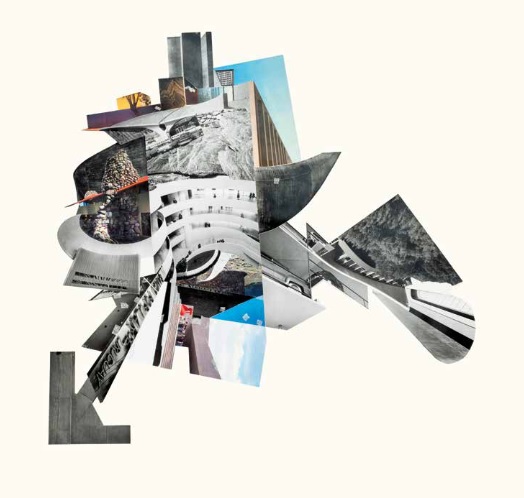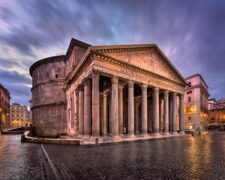
Marshall Brown
American, 1973-
Pantheon, 2020
collage on archival paper
47 1/4 × 49 in.
SBMA, Museum purchase with funds provided by the General Art Acquisition fund
2022.8.1

Marshall Brown - undated photo
"By sampling from the inherited material of architectural history, the production of space becomes an act of honorific thievery."
- Marshall Brown

Pantheon in the Morning, Rome, Italy | Anshar Images
COMMENTS
Many of [Brown’s works] have an explosive character, enticing us, as in the image of the interior of Frank Lloyd Wright’s Guggenheim Museum in 2020’s “Pantheon”, for instance, into a whirlwind of imagery before spitting us out into the corners with a fragment of a truss that just happens to form an arrow pointing to the lower left-hand corner, or a curving staircase tumbling upside down toward a petal-shaped image of a curved window frame. What if the motion of Wright’s continuous ramp could continue through and past the building, and involve, distort, and fling apart the structure, the walls, the windows, and every other element of what we think makes up a building? This is the question Brown is asking here. The answer is that it is possible in the collage.
- Marshall Brown Catalogue, p. 43
Believing that the architect’s role is to test and expand the boundaries of reality, Marshall Brown’s projects give form to the interactions between architecture, power, and acts of world making. Brown moves between various scales of architecture and diverse conceptual frameworks, embodying new relationships between the one and the many. Invested in the material history of architecture, he constructs visions of urban worlds yet to come using collage, architectural drawings on drafting vellum, sketches on tracing paper, video, models, objects, and built projects.
Brown’s recent collages sample from the history of modern and contemporary architecture to create new forms of monumentality. Crossing disciplinary boundaries and extending from the intertwined histories of modern art and architecture, his collages create new connections, associations, and meanings among disconnected architectural and urban remnants. Brown dissects imagery from photographs taken during the golden age of post-war architectural photography, using the historically disruptive properties of collage and montage to create new forms, spaces, and narratives. His curated fragments–culled from monographs on significant figures from the history of architectural photography–are hand-cut and fused together onto Arches hot press watercolor paper. Looming facades, stark shadows, and structural details support one another to form unique architectural spaces and narratives — offering no site or function, Brown’s assemblages look toward new, boundless spaces.
Marshall Brown is an architect, urbanist, and futurist whose work creates new connections, associations, and meanings among disconnected architectural and urban remnants. His work is in the collections of the Art Institute of Chicago, Crystal Bridges Museum of American Art in Arkansas, the San Francisco Museum of Modern Art, the Santa Barbara Museum of Art, the Museum of Contemporary Photography and the University Club, both in Chicago. Brown’s work has been exhibited at the 2016 Venice Architecture Biennale, the 2017 Chicago Architecture Biennial, the Museum of Contemporary Art Detroit, The Arts Club of Chicago, the Architecture and Design Museum Los Angeles, and recently in a 10-year survey, Recurrent Visions: The Architecture of Marshall Brown Projects, at the Princeton University School of Architecture. His projects and essays have appeared in several books and journals, including The New York Times Magazine, Metropolis, Crain’s, Architectural Record, Art Papers, The Believer, the Journal of Architectural Education and Log. Marshall Brown received his masters’ degrees at Harvard University. Brown is represented by Western Exhibitions and he currently lives in New Jersey. He is an associate professor at Princeton University.
https://westernexhibitions.com/artist/marshall-brown/
